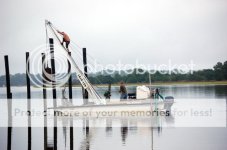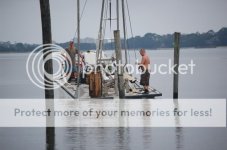Guerillabill
New member
- Joined
- May 9, 2009
- Messages
- 32
- Reaction score
- 0
- C Dory Year
- 1996
- C Dory Model
- 22 Angler
Idiots in Boats
We took our C-Dory 22' out for her maiden voyage yesterday. It isn't a new boat, but new to us.
After purchasing it, I've had it in the shop getting the motor tuned up, and then I basically rewired the boat and replaced all the electronics.
So after having the boat for two months, and not having had it in the water yet, we were excited out our maiden voyage.
We left Venice, Fl at about 9:30AM, and ran north up the intracoastal past Sarasota Bay, and then back to port.
Spent about 6 hours on the boat, testing out all the gear, running the motor at different RPMs, and just getting familiar with the boat's handling.
It was a great trip.
The boat ran flawlessly, and we discovered that the 4 stroke Suzuki 70 could quickly get the boat up to 20mph at around 4000rpm.
But most of the day we spent cruising at about 2100 RPM which was about 6.5 mph.
We did encounter some interesting situations on the water.
For example, as we approached one of the drawbridges which was being opened to allow a larger boat to pass under it, the boat in front of us decided to stop and take pictures of the larger boat as it passed under the bridge.
So the 'captain' of that boat turned off his motor, and stood up in the boat to take photos.
When he did, the current caught his boat, turned it sideways in front of the approaching boat that was passing under the bridge.
We were behind the boat taking photos, and had to stop and back up and maneuver to shore so the large boat could maneuver around the photo boat as it blocked the larger boat's passage under the bridge.
The two boats almost collided under the draw bridge - and the guy taking the photo never realized he was almost crushed by the larger boat - he just kept taking photos.
The larger boat did manage to squeeze by, and his captain waved and yelled 'thank you' to us as he came by - because we had made a path for him to get around the photo guy.
Further up the intracoastal, we saw a man rowing a single scull rowing shell, coming in from starboard out of an inlet, passing across the lane.
He was sitting facing backward in the boat, so he couldn't see where he was going, but he was moving pretty fast.
Unfortunately, he did not see the 42' cruiser heading down the intracoastal, and the captain of that boat did not see him - until they were about 12 feet apart.
Had the captain of that 42' cruiser not seen the rower and sounded his horn, it would probably have been a fatality.
The large boat could not veer too far off course due to the low depth in that part of the intracoastal and had to rely on the rower to get out of the way.
The bow wave from the cruiser picked up and threw the rowing scull away from the boat, and into our path.
We had been expecting that, and had already powered down to a full stop.
The rower was wet, but otherwise unharmed. And hopefully a little wiser.
Another few miles up, we saw a large boat heading our way at very high speed, throwing up a large wake.
Even at 300 yards, we could see how large a wake it was, and started taking photos.
We knew this tsumani sized wake in the limited space of the intercoastal was going to have an effect on us, so we moved over as far to the right as we could, and prepared to turn 90 degrees across the wake as soon as the boat passed.
We did the 90 degree turn to cross the wake, but the wake was a fast rolling 6 footer which picked us up, and dropped us into the mud at the waterline on the far edge of the lane.
As we dropped into the mud, the motor died when the prop hit the mud.
It took us a few seconds to realize what had happened, why the motor died, and why our depth finder was showing 0 feet.
As the wake from the fast moving boat recinded, we floated up off the mud, and were able to restart the boat on the first crank.
We were amazed that the guy driving the big boat showed so little concern about the speed limit on the intracoastal or the problems he was causing other boats and damage to boats in docks.
But we survived, and learned a lesson.
We learned to look for these kinds of situations, and to be sure to not get caught in one if there are concrete seawalls on your side.
A wave that leaves you in the mud is nothing compared to being pushed into a seaway at speed.
As the day passed, we discovered that at almost every draw bridge, tourists in rental boats would stop their boats near or under the bridges to take photos, and in the process almost always caused other boats to take evasive action.
And we discovered that other than the one jerk in the big boat with the tsumani wake, most large boat owners were aware of their wakes, and were careful to not cause problems for other boats.
We did have a good time, we were extremely happy that the C-Dory did well, we were impressed that the Suzuki motor ran flawlessly, and that we arrived back home safe and sound.
Can't wake for the next trip.
Bill
We took our C-Dory 22' out for her maiden voyage yesterday. It isn't a new boat, but new to us.
After purchasing it, I've had it in the shop getting the motor tuned up, and then I basically rewired the boat and replaced all the electronics.
So after having the boat for two months, and not having had it in the water yet, we were excited out our maiden voyage.
We left Venice, Fl at about 9:30AM, and ran north up the intracoastal past Sarasota Bay, and then back to port.
Spent about 6 hours on the boat, testing out all the gear, running the motor at different RPMs, and just getting familiar with the boat's handling.
It was a great trip.
The boat ran flawlessly, and we discovered that the 4 stroke Suzuki 70 could quickly get the boat up to 20mph at around 4000rpm.
But most of the day we spent cruising at about 2100 RPM which was about 6.5 mph.
We did encounter some interesting situations on the water.
For example, as we approached one of the drawbridges which was being opened to allow a larger boat to pass under it, the boat in front of us decided to stop and take pictures of the larger boat as it passed under the bridge.
So the 'captain' of that boat turned off his motor, and stood up in the boat to take photos.
When he did, the current caught his boat, turned it sideways in front of the approaching boat that was passing under the bridge.
We were behind the boat taking photos, and had to stop and back up and maneuver to shore so the large boat could maneuver around the photo boat as it blocked the larger boat's passage under the bridge.
The two boats almost collided under the draw bridge - and the guy taking the photo never realized he was almost crushed by the larger boat - he just kept taking photos.
The larger boat did manage to squeeze by, and his captain waved and yelled 'thank you' to us as he came by - because we had made a path for him to get around the photo guy.
Further up the intracoastal, we saw a man rowing a single scull rowing shell, coming in from starboard out of an inlet, passing across the lane.
He was sitting facing backward in the boat, so he couldn't see where he was going, but he was moving pretty fast.
Unfortunately, he did not see the 42' cruiser heading down the intracoastal, and the captain of that boat did not see him - until they were about 12 feet apart.
Had the captain of that 42' cruiser not seen the rower and sounded his horn, it would probably have been a fatality.
The large boat could not veer too far off course due to the low depth in that part of the intracoastal and had to rely on the rower to get out of the way.
The bow wave from the cruiser picked up and threw the rowing scull away from the boat, and into our path.
We had been expecting that, and had already powered down to a full stop.
The rower was wet, but otherwise unharmed. And hopefully a little wiser.
Another few miles up, we saw a large boat heading our way at very high speed, throwing up a large wake.
Even at 300 yards, we could see how large a wake it was, and started taking photos.
We knew this tsumani sized wake in the limited space of the intercoastal was going to have an effect on us, so we moved over as far to the right as we could, and prepared to turn 90 degrees across the wake as soon as the boat passed.
We did the 90 degree turn to cross the wake, but the wake was a fast rolling 6 footer which picked us up, and dropped us into the mud at the waterline on the far edge of the lane.
As we dropped into the mud, the motor died when the prop hit the mud.
It took us a few seconds to realize what had happened, why the motor died, and why our depth finder was showing 0 feet.
As the wake from the fast moving boat recinded, we floated up off the mud, and were able to restart the boat on the first crank.
We were amazed that the guy driving the big boat showed so little concern about the speed limit on the intracoastal or the problems he was causing other boats and damage to boats in docks.
But we survived, and learned a lesson.
We learned to look for these kinds of situations, and to be sure to not get caught in one if there are concrete seawalls on your side.
A wave that leaves you in the mud is nothing compared to being pushed into a seaway at speed.
As the day passed, we discovered that at almost every draw bridge, tourists in rental boats would stop their boats near or under the bridges to take photos, and in the process almost always caused other boats to take evasive action.
And we discovered that other than the one jerk in the big boat with the tsumani wake, most large boat owners were aware of their wakes, and were careful to not cause problems for other boats.
We did have a good time, we were extremely happy that the C-Dory did well, we were impressed that the Suzuki motor ran flawlessly, and that we arrived back home safe and sound.
Can't wake for the next trip.
Bill



